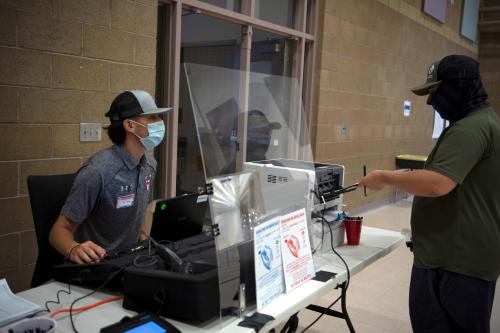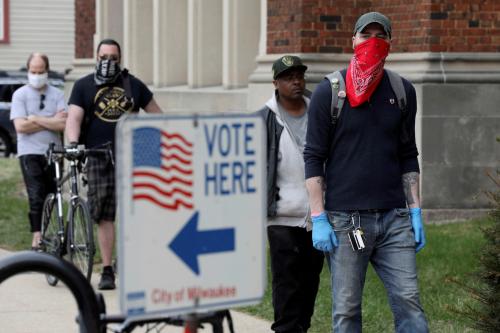Here at Brookings we were among the first to warn that election night might turn out to be election month.
That could still happen, especially if the race between President Trump and former Vice President Biden turns out to be closer than polls currently indicate. But even if the race is not close, the unprecedented number of early votes and votes by mail combined with what could be record-high turnout means that it may simply take longer to count the votes in some states than it ever has before. So, let’s look at some of the things we should be looking for on an election night that promises to be unlike any election night we’ve seen before.
As in prior years there will be two types of data coming into the major networks and news sources on election night: exit polling and actual vote counts. But the differences will pose challenges to data scientists regarding when to call states and for whom. For instance, this year, given that 50 percent or more of the vote might be by mail or ballot drop-box, the consortium which conducts exit polls for all major news outlets will have to sample not just voters who go to the polls on Election Day, but also those who voted by mail or who voted absentee—the latter two at significantly higher levels than before. They are planning to do this, but it could be complicated in states that do not release sufficient data regarding early voting.
When the polls close and votes actually start coming in, the totals may or may not include votes by mail depending on the state.
Hopefully the networks will not make calls until the mix of Election Day votes, in-person early votes, and mail/absentee ballot reporting reflects the overall composition of the vote. In the past, in most states, absentee ballots were generally not sufficient in size or in difference from initial counts to change statewide election outcomes. But in a year rocked by COVID-19, much of our prior expectations about the timing of vote counting must be tossed out the window as unprecedented numbers of voters got to the polls early and as states change rules around their elections—in some cases significantly.
With these caveats in mind, we have a few tips for what to look for leading up to, on, and after Election Day. Here is our advice, in chronological order.
Right now
Don’t fear a slow count. First and foremost, Americans should prepare for the possibility that the vote count is a protracted one. What voters should not do is conflate a slow count with a fraudulent or a compromised one. Quite the contrary, a slow count signals a close race and that states are carefully and diligently working to ensure the count accurately reports the winner. If next Tuesday is a landslide win for one of the candidates, we will probably know the result that evening. If it is a close race—or if a close race exists in several key states—a delayed outcome reflects a system working precisely as it should and as voters should want it to work.
The day before the election
Understand the timing of vote counting. For all of the discussion of counting delays, changes in many states may streamline the counts. Several states—including states with competitive races like Florida, North Carolina, Texas (in more populated cities), Arizona and Nebraska—begin counting early votes well in advance of election night. In these states, they will have the vast majority of early votes counted and ready to announce immediately upon the closure of polls. In these states, significant vote totals may be announced earlier than usual in the night or at a normal time.
Another set of states begin counting early votes in the morning on Election Day. They include states with competitive races like Georgia, Texas (smaller cities), Michigan, Pennsylvania, and Wisconsin. In these states, while their counting may not be as efficient as a state like Florida that can begin counting more than two weeks out, they will have a significant jump-start on getting the job done.
Other jurisdictions begin counting votes sometime during the day on Election Day or once polls close. In a close election, those states—and any early count states with close races that continue to receive absentee votes on Election Day and after—may drag out the determination of the winner. If the winner is ahead by a significant amount, those pre-count states may push a candidate above the 270 electoral vote mark on election night or shortly thereafter.
Election Day morning
Watch where each candidate starts. Because America is so polarized, there are states that are very likely to fall into one candidate’s column or another. Biden is consistently polling ahead in each of the states that Hillary Clinton won, which would give him a starting point of 232 electoral college votes. Trump has a starting point of 125 electoral votes.
Lunchtime
Watch the early vote totals. The best site for this is Michael McDonald’s U.S. Elections Project. McDonald (a former colleague of ours) is meticulously using early voting data to compile a database that examines both mail ballot and in-person early votes. At the time of publishing this piece, 84 million early votes had been cast—just over 60% of all the votes cast in 2016—and that number is growing significantly by the day. A high-turnout election does not necessarily benefit one candidate over another, as the outcome depends significantly on who turns out. However, Michael’s data can show us which states seem to be turning out in higher numbers, and it is in those states that it is important to dive into exit polls to see what is changing in the electorate.
Before 6:00 PM (EST)
This is when the networks start releasing the earliest exit polls. Watch those exits, especially once polls close. Have a look at the following categories. In 2016, Trump won the suburban vote by 4 points. He won voters 65 and older by 7 points. He won independents by 4 points and college-educated white voters by 3 points. In 2016 Trump won these categories while losing the overall popular vote. So, if on election night Biden is cutting into those margins or even winning in these categories it could be an early sign of a Biden victory.
And beyond the groups that Trump won narrowly, it is important to look at his margin of victory among groups he won mightily. Anywhere that Biden is able to cut into Trump’s lead from 2016 —white women (Trump +9), non-college educated whites (Trump +37), or voters with military service (Trump +27)—are additional votes that will matter significantly. In those categories it may be less about if Biden loses those groups, but more about whether he loses them by less than Clinton did.
Finally, the exit polls show us the composition of the electorate, and these numbers can be just as important. It matters not just who wins which group, but how large a part of the population that group represents. So, a few data points to keep an eye on are young voters, women voters, and first-time voters. With reports of unprecedented increases among these groups in states like Texas, understanding the relative share of the electorate could help Biden or help Trump. In 2016, people under the age of 30 made up 19% of voters, women were 53% of the electorate and only 1 in 10 voters were going to the polls for the first time.
When polls begin to close at 6:00 PM (EST)
Appreciate the distinction between news organizations’ use of “Too Early to Call” and “Too Close to Call.” “Too Early to Call” typically means a state is likely to break in the direction it is expected (New York for Democrats; Mississippi for Republicans) but that there is insufficient data to make that call. This year, there will likely be a lot of “too early to call” states that are declared immediately upon polls closing. However, if there are a number of states labeled “too close to call,” it could suggest trouble for a candidate. In 2016 a number of states Clinton was supposed to perform quite well in—Wisconsin, Michigan, Minnesota, and others—were labeled “too close to call” and held in that position for some time. These were the first signs that the overwhelming Clinton victory was not panning out and that Donald Trump was overperforming some of the state-level polls and pundits’ expectations (the authors of this piece included).
Starting at 7:00 PM (EST)
Watch Florida! Polls close for most of Florida at 7:00 PM (EST). Florida is worth watching for many reasons. Trump won a narrow victory there in 2016 (1.2 percentage points) and it is very competitive this time around as well. But perhaps most important is the fact that Florida has a large number of absentee ballots (including the president’s) and it starts counting mail ballots earlier than any other state: 22 days ahead of Election Day. All Florida ballots have to be in by 7:00 PM on Election Day so the absentee ballot count may not be totally complete. Nonetheless, as of a week before Election Day Floridians had already cast 7.3 million ballots over 75% of the number cast in the entire 2016 election. Of all the states in the Eastern Standard time zone Florida, is the most likely to be able to report comprehensive vote totals on election night. If Biden or Trump have a large lead it could be indicative of what happens as the clock moves west; if it’s close it could be a long night.
Starting at 7:30 PM (EST)
Watch North Carolina! Polls close there at 7:30 PM (EST). North Carolina starts counting its absentee ballots 14 days before Election Day. So, as the results come in on election night we can expect to see them reflecting a large number of absentee ballots/early votes as well as in-person votes. Unlike Florida, however, North Carolina will also count ballots that come in 3 days after Election Day. The count on election night, if close, could change by the time all the votes are in. When watching these results remember that in 2016 Trump carried the state by 3.6%. But this year, polls are showing an even split. There is also a competitive Senate race where incumbent Thom Tillis (R) is being challenged by Democrat Cal Cunningham. Lastly, North Carolina’s popular Democratic governor, Roy Cooper, is on the ballot for reelection and his support could buoy Biden with a “reverse coattails effect” (more on this below). If early numbers in North Carolina show Democratic strength at the presidential and Senate level it could be a good night for Biden.
Starting at 8:00 PM (EST)
Watch Maine’s 2nd congressional district! Polls close here at 8:00 PM (EST). Maine’s 2nd congressional district is the second most rural district in the United States. And while Maine normally votes for a Democrat for president, it awards two of its four electoral votes to the statewide winner, and the other two electoral votes to the candidate who won in the state’s respective congressional districts. Donald Trump won this single electoral vote in Maine in 2016. This year polling suggests that Joe Biden is poised to win all four of Maine’s electoral votes. This could be happening, in part, because of an uncommon effect in American politics: reverse coattails. The district’s representative in Congress, Democrat Jared Golden, is polling about 25 points ahead of his Republican rival in a district that is usually Republican-leaning or competitive (Golden won his seat by 1.3% in 2018, and in 2016 Republican Bruce Poliquin won it by 9.6%). Golden’s popularity and the diminishing impact of split-ticket voting could mean that a popular House Democrat has the coattails to improve the performance of a Democratic presidential nominee!
Watch North and South Dakota. By 8:00 PM (EST) polls in South Dakota will be closed, plus some in North Dakota. Donald Trump won these states by significant margins (North Dakota by 35 points; South Dakota by 30 points). However, during the month of October, and especially over the last two weeks, these two states have seen some of the most significant spikes in COVID-19 cases in the country. These states may be ground zero for a referendum on the president’s handling of the pandemic. This is not to say we believe President Trump will lose either of the Dakotas; he won’t. But, if Biden is able to cut into his vote in these two states, it may shine light on the broader public’s response to this issue.
Throughout Election Day and beyond
Read into early returns responsibly. There will be a tendency to try to take stock of what is happening broadly in the race based on what happens with the earliest returns. That would be a mistake. However, some states may signal broader trends happening in the electorate. For example, if swing states in the east are still counting votes and the AP declares that Biden has won Arizona or Texas, or results show Biden notably ahead in those states deep into the count, it’s probably a sign that Biden is having a good night. Similarly, if Biden is ahead significantly in Florida, it won’t mean he is on his way to a landslide but it likely indicates that he will have the votes needed to cross the 270 mark. Alternatively, if states Biden is expected to win—New Hampshire, Maine, Minnesota, and Virginia—start to break for Trump, either by a declared win or a lead that remains stable deep into the night, it likely signals that in the other swing states, the president is performing quite well.
Regardless of what happens on election night and the days and weeks following, voters need to remain patient. Administering nationwide elections is a complex operation, which has been made even harder by a public health crisis and drops in local tax revenue due to the recession. We may not know who won the presidency, a given Senate race, or control of a state legislature on election night, the day after or the end of the week, and that’s alright. It means the system is working—if slowly—to ensure every vote is counted and that when a secretary of state is ready to declare a winner, we can be confident in that outcome.








Commentary
What to watch for on election night 2020
October 30, 2020